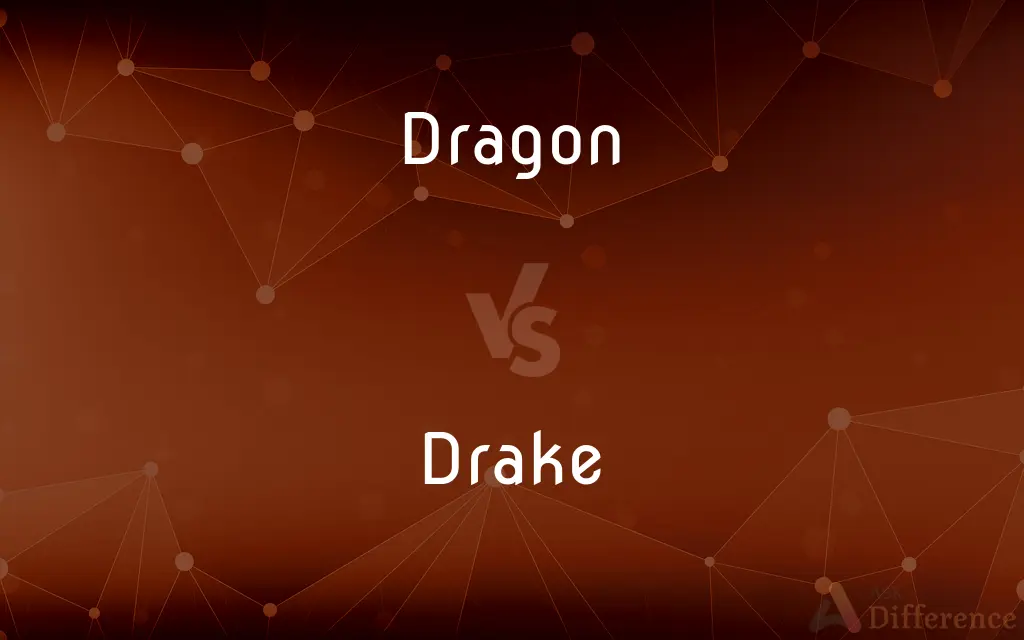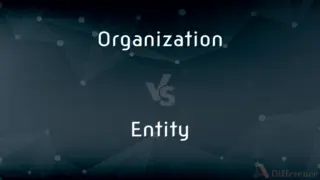Dragon vs. Drake — What's the Difference?
By Fiza Rafique & Maham Liaqat — Updated on March 7, 2024
A dragon is a mythical creature often depicted with wings and the ability to breathe fire, while a drake is typically seen as a smaller or male version of a dragon, with various interpretations across cultures.

Difference Between Dragon and Drake
Table of Contents
ADVERTISEMENT
Key Differences
Dragons are legendary creatures known across many cultures for their fearsome appearance and magical abilities, including flight and fire-breathing. In contrast, drakes are often depicted as a specific type of dragon or a male dragon, with their portrayal varying significantly between different mythologies and stories.
In European folklore, dragons are large, winged beasts, symbolizing chaos and destruction. Drakes, on the other hand, may be depicted as earthbound and less majestic, lacking the ability to breathe fire or fly, which sets them apart from their more powerful counterparts.
The term "dragon" encompasses a wide range of creatures in myths worldwide, from the serpent-like dragons of East Asian traditions to the treasure-guarding dragons of Western tales. Drakes, however, are more narrowly defined and are often not as deeply integrated into cultural mythologies as dragons, suggesting a more specific or lesser role in folklore.
Dragons have been a part of mythology and literature for centuries, representing power, wisdom, or malevolence, depending on the culture. Drakes, while also present in literature, often play a less prominent role, sometimes considered lesser dragons or specific to certain stories where their traits are distinct from traditional dragons.
In modern fantasy literature and games, dragons are pivotal characters or obstacles, embodying ancient wisdom or catastrophic challenges. Drakes might be featured as lesser creatures within the same universe, offering variations in challenges or roles but lacking the grandeur or significance of dragons.
ADVERTISEMENT
Comparison Chart
Definition
Mythical creatures known for their size, power, and magical abilities.
Often portrayed as a male dragon or a lesser form of a dragon.
Symbolism
Power, wisdom, destruction, or protection.
Generally considered less powerful or significant.
Abilities
Flight, fire-breathing, and magical powers.
May have reduced abilities, such as lacking flight or fire-breathing.
Compare with Definitions
Dragon
Mythical beasts often symbolizing power or chaos.
The dragon guarded the ancient treasure with fierce determination.
Drake
Often a term for a male dragon in fantasy lore.
The drake, unlike his larger kin, could not breathe fire.
Dragon
A creature of legend capable of flight and breathing fire.
Legends tell of a dragon that could darken the skies with its wings.
Drake
Sometimes used to describe real-life animals with dragon-like features.
The Komodo dragon is also known as the Komodo drake in some folklore.
Dragon
A common antagonist or ally in fantasy stories.
The hero sought the dragon's alliance to save the kingdom.
Drake
A smaller or lesser dragon in some tales.
Drakes roamed the forests, avoiding humans and larger dragons.
Dragon
A figure represented in various global mythologies.
Every culture has its own version of the dragon, each with unique attributes.
Drake
In medieval lore, sometimes a specific type of dragon.
The knight faced a drake, a creature less formidable than a dragon but still dangerous.
Dragon
A symbol of wisdom and longevity in some cultures.
The dragon is revered for its wisdom and age in many Eastern traditions.
Drake
Featured in modern games and literature as distinct creatures.
In the game, players can tame drakes as mounts, unlike the untamable dragons.
Dragon
A dragon is a large, serpentine, legendary creature that appears in the folklore of many cultures worldwide. Beliefs about dragons vary considerably through regions, but dragons in western cultures since the High Middle Ages have often been depicted as winged, horned, four-legged, and capable of breathing fire.
Drake
A male duck
A drake mallard
Dragon
A mythical monster traditionally represented as a gigantic reptile having a long tail, sharp claws, scaly skin, and often wings.
Drake
A male duck.
Dragon
Any of various lizards, such as the Komodo dragon or the flying lizard.
Drake
A mayfly used as fishing bait. Also called drake fly.
Dragon
A fiercely vigilant or intractable person.
Drake
A male duck.
Dragon
Something very formidable or dangerous.
Drake
A mayfly used as fishing bait.
Dragon
(Archaic) A large snake or serpent.
Drake
(poetic) A dragon.
Dragon
A legendary serpentine or reptilian creature.
Drake
(historical) A small piece of artillery.
Dragon
In Western mythology, a gigantic beast, typically reptilian with leathery bat-like wings, lion-like claws, scaly skin and a serpent-like body, often a monster with fiery breath.
Drake
A fiery meteor.
Dragon
In Eastern mythology, a large, snake-like monster with the eyes of a hare, the horns of a stag and the claws of a tiger, usually beneficent.
Drake
A beaked galley, or Viking warship.
Dragon
An animal of various species that resemble a dragon in appearance:
Drake
The male of the duck kind.
Dragon
(obsolete) A very large snake; a python.
Drake
The drake fly.
The drake will mount steeple height into the air.
The dark drake fly, good in August.
Dragon
Any of various agamid lizards of the genera Draco, Physignathus or Pogona.
Drake
A dragon.
Beowulf resolves to kill the drake.
Dragon
A Komodo dragon.
Drake
A small piece of artillery.
Two or three shots, made at them by a couple of drakes, made them stagger.
Dragon
The constellation Draco.
Drake
Wild oats, brome grass, or darnel grass; - called also drawk, dravick, and drank.
Dragon
(pejorative) A fierce and unpleasant woman; a harridan.
She’s a bit of a dragon.
Drake
English explorer and admiral who was the first Englishman to circumnavigate the globe and who helped to defeat the Spanish Armada (1540-1596)
Dragon
The (historical) Chinese empire or the People's Republic of China.
Napoleon already warned of the awakening of the Dragon.
Dragon
(figuratively) Something very formidable or dangerous.
Dragon
A type of playing-tile (red dragon, green dragon, white dragon) in the game of mahjong.
Dragon
A luminous exhalation from marshy ground, seeming to move through the air like a winged serpent.
Dragon
A short musket hooked to a swivel attached to a soldier's belt; so called from a representation of a dragon's head at the muzzle.
Dragon
A background process similar to a daemon.
Dragon
A variety of carrier pigeon.
Dragon
(slang) A transvestite man, or more broadly a male-to-female transgender person.
Dragon
A fabulous animal, generally represented as a monstrous winged serpent or lizard, with a crested head and enormous claws, and regarded as very powerful and ferocious.
The dragons which appear in early paintings and sculptures are invariably representations of a winged crocodile.
Thou breakest the heads of the dragons in the waters.
Thou shalt tread upon the lion and adder; the young lion and the dragon shalt thou trample under feet.
He laid hold on the dragon, that old serpent, which is the Devil and Satan, and bound him a thousand years.
Dragon
A fierce, violent person, esp. a woman.
Dragon
A constellation of the northern hemisphere figured as a dragon; Draco.
Dragon
A luminous exhalation from marshy grounds, seeming to move through the air as a winged serpent.
Dragon
A short musket hooked to a swivel attached to a soldier's belt; - so called from a representation of a dragon's head at the muzzle.
Dragon
A small arboreal lizard of the genus Draco, of several species, found in the East Indies and Southern Asia. Five or six of the hind ribs, on each side, are prolonged and covered with weblike skin, forming a sort of wing. These prolongations aid them in making long leaps from tree to tree. Called also flying lizard.
Dragon
A variety of carrier pigeon.
Dragon
A fabulous winged creature, sometimes borne as a charge in a coat of arms.
Dragon
A creature of Teutonic mythology; usually represented as breathing fire and having a reptilian body and sometimes wings
Dragon
A fiercely vigilant and unpleasant woman
Dragon
A faint constellation twisting around the north celestial pole and lying between Ursa Major and Cepheus
Dragon
Any of several small tropical Asian lizards capable of gliding by spreading winglike membranes on each side of the body
Common Curiosities
What distinguishes a dragon from a drake?
Dragons are typically larger, possess a wider range of magical abilities, and play more significant roles in mythology, whereas drakes are often smaller and have more specific or limited abilities.
Why are dragons featured so prominently in mythologies around the world?
Dragons symbolize various human emotions and concepts, such as fear, power, wisdom, and the unknown, making them versatile figures in storytelling.
How do modern interpretations of dragons and drakes differ from traditional ones?
Modern interpretations often blend various cultural aspects of these creatures, sometimes giving them more nuanced roles in stories or emphasizing their intelligence and moral complexity.
Are dragons always depicted as evil?
No, dragons' portrayal varies widely among cultures; in some, they are wise protectors, while in others, they are destructive forces.
Can both dragons and drakes be found in the same fantasy universe?
Yes, many fantasy universes include both, with drakes often positioned as a lesser class of dragon, offering diversity in the challenges characters face.
Is the term "drake" historically accurate?
"Drake" has been used historically in different contexts, including as a term for dragons, though its specific meaning can vary widely depending on the source.
Are drakes always male?
In some stories and games, "drake" specifically refers to a male dragon, but this is not a universal rule across all interpretations.
Do drakes have wings?
This depends on the specific lore or fantasy universe. In some tales, drakes may have wings but often of a lesser span or functionality compared to dragons.
Can drakes breathe fire?
This varies by mythology, but drakes are often depicted with reduced abilities compared to dragons, sometimes lacking the ability to breathe fire.
Do dragons and drakes appear in all cultures?
While not every culture has a concept of dragons or drakes, many have similar mythical creatures that fulfill comparable roles in their mythologies.
Share Your Discovery

Previous Comparison
Gerry vs. Jerry
Next Comparison
Organization vs. EntityAuthor Spotlight
Written by
Fiza RafiqueFiza Rafique is a skilled content writer at AskDifference.com, where she meticulously refines and enhances written pieces. Drawing from her vast editorial expertise, Fiza ensures clarity, accuracy, and precision in every article. Passionate about language, she continually seeks to elevate the quality of content for readers worldwide.
Co-written by
Maham Liaqat














































